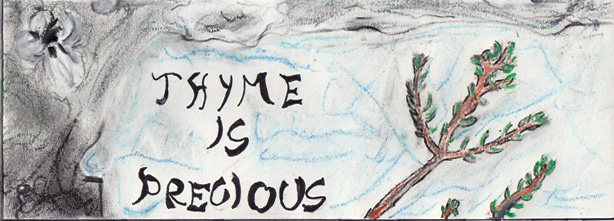References
Barry, R. G. 1981. Mountain weather and climate. Methuen &
Co., New York, New York, United States of America.
Buckle, J. 2003. Clinical aromatherapy: essential oils in
practice. Elseivier Science, United States of America.
Foster, S. and J. A. Duke. 2000. Thymus vulgaris L.:
Mint Family. Peterson Field Guide to Medicinal Plants & Herbs of
Eastern & Central North America 2000: 261.
Golparvar, A. G. and B. Bahari. 2011. Effects of phonological
stages on herbage yield and quality/quantity of oil in garden
thyme (Thymus vulgaris). Journal of Medicinal Plants Research
Vol. 5: 6085-6089.
Linhart, Y. B. and J. D. Thompson. 1999. Thyme is of essence:
Biochemical polymorphisim and multi-species deterrence.
Evolutionary Ecology Research 1: 151-171.
Missouri Botanical Garden.Thymus vulgaris.
http://www.missouribotanicalgarden.org/gardens-gardening/your-garden/plant-finder/plant-details/kc/f970/thymus-vulgaris.aspx.
Accessed 5 May 2012.
Moore, D.M., et al. 1988. The Marshall Cavendish illustrated
encyclopedia of plants and earth sciences. Marshal Cavendish,
New York, United States of America.
Smolik, M., D. Jadjzak and S. Korzeneniewska. 2009. Assessment
of Morphological and Genetic Variability in some Thymus
Accessions Using Molecular Markers. Notulae
Botanicae Horti Agrobotanaci Cluj-Napoca 37: 234-240.
Statl-Biskup, E. and F. Saez. 2002. Thyme: the genus Thymus.
Taylor & Francis, New York, New York, USA.
Thompson, J. D., D. Manicacci and M. Tarayre. 1999. Thirty-Five
Years of Thyme: A Tale of Two Polymorphisms. Bioscience 48:
805-815.
USDA. 2012. Plants Profile: Thymus vulgaris. <URL:http://plants.usda.gov/java/profile?symbol=THVU>.
Accessed 28 March 2012.
Uremis, I., M. Arslant and M. K. Sangun. 2009. Herbicidal
Activity of Essential Oils on the Germination of Some Problem
Weeds. Asian Journal of Chemistry 21: 3199-3210
